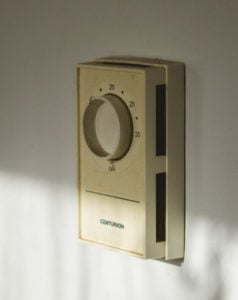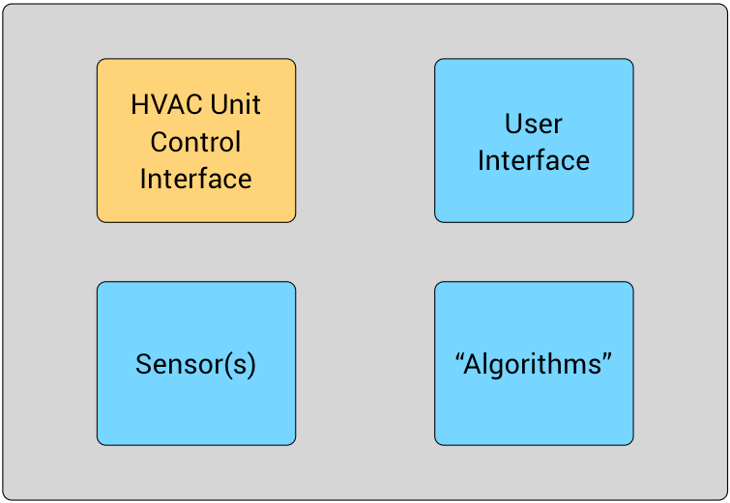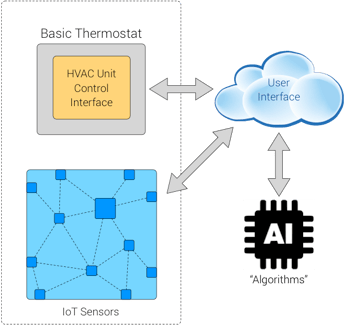Our previous blog peered into the future of HVAC, which reveals AI and IoT. Don’t ignore them as far off. They’re here now, changing the competitive landscape, and unlocking the HVAC market. We’ll show you how.
![]()
The HVAC market has existed for 135 years! Automated room temperature control hasn’t changed much since the beginning. Unfortunately, sad but true.
We love our thermostats because they deliver comfort. Not surprisingly, we haven’t thought about them too much over the years. Concerns about energy efficiency, performance and sustainability have brought a new focus on HVAC.
You’ve also heard a lot about AI. Big Data, machine learning, anomaly detection, and analytics are common terms you hear today. At the same time, you’ve heard about IoT. Maybe too much due to the surrounding hype. It’s real so ignore IoT at your peril. Regardless, AI will play a key role in driving IoT.
Change Arrives in the HVAC Market
 Take a look at your thermostat. Take your time if you have to go to another room. Hopefully, it doesn’t look like this.
Take a look at your thermostat. Take your time if you have to go to another room. Hopefully, it doesn’t look like this.Even if it does look similar, you still might say, “But it works just fine!” Technologists would shudder. Certainly, they're probably. A closer examination, however, reveals a much closer call.
Remember now, that your current thermostat was the result of over 100 years of development since the first thermostat. Now, we have “smart” thermostats. The primary difference between a conventional thermostat and a “smart” thermostat is “algorithms.”
The four main parts of the “smart” thermostat include the following:
- HVAC Unit Control Interface – low-voltage wires
- Sensor(s)
- User Interface
- “Algorithms”

Conventional thermostats (even the one pictured above) include all the elements except for the “algorithms.” Typical “smart” thermostats integrate all of these elements into a single device. Aside from tradition, no reason exists for such an integrated design.
Recently, cloud-based Amazon Alexa commands have shown the ability to control a “smart” thermostat. Significantly, a decoupling of this intelligence from the “smart” thermostat gives you a clue to the future of HVAC.
AI and IoT Cracks the HVAC Code
A thermostat requires the HVAC Unit Control Interface to perform its primary function. You need the physical wired interface to transmit control commands to the HVAC unit. Is anything else needed within the thermostat itself? Not really. As you'll see, AI and IoT dictate such a result.
New Sensors Bring Obsolescence
Wireless technology did not exist 135 years ago. The first thermostats had to integrate the temperature sensor. There was no other option.
Today, integration invites obsolescence. Even the best “smart” thermostats have limited sensor technology. For example, some “smart” thermostats can generate an estimate of energy consumption. Certainly, measuring the actual energy consumption would improve the “algorithms.” Simply put, there are many pieces of information that would benefit the “algorithms.”
Physical sensors represent one type of data. How about adding additional temperature sensors from additional rooms in the heating/cooling zone? How about more occupancy sensors or the latest IAQ sensors?
Occupant data represents another type of data. How about considering individual preferences for environment comfort. Individuals have different temperature sensitivities. Thus, the identification of the individual actually present in the space can lead to further energy savings based on their preferences. For example, the “algorithm” would not need to cool the space as much if the occupant preferred a warmer temperature.
New types of use cases will always emerge. Each new use case will demand additional types of data. Sadly, an integrated thermostat unit locks you into the past. Leveraging additional data beyond the thermostat itself reduces the risk of obsolescence. Wireless IoT sensors solve this problem.
A future-proof HVAC solution results.

User Interface
Consider some simple questions. Why should my user interface be integrated with the thermostat? Why do I even need a user interface on the thermostat? Everyone has a suitable user interface on them . . . anytime, anywhere. It’s called your phone; your go to for information.
You have been programmed to recognize your phone as your portal into real-time data, analytics and controls. The world constantly changes and your phone keeps you informed. Is there any reason for me not to use my phone as my primary interface to my “smart” thermostat? Yes. The sunk cost of the glass on your “smart” thermostat is the reason. You paid for it so you should probably use it. I can’t think of any other reason why.
Let’s move the user interface from the thermostat to the cloud. If so, the thermostat is then free to perform one function: control the HVAC unit. All instructions that direct the HVAC unit can be moved to the cloud. You’re now free to ignore your thermostat in the other room.
AI “Algorithms”
You need “algorithms” to be smart. We accept that. IoT sensor data transported to the cloud becomes Big Data. As we know, AI engines love Big Data, as much as they can acquire. Let them crunch on any and all sources of data to bring their “algorithms” to life. Let them learn from the data, identify irregularities in the data, and detect problems before they arise. I’m sure those subject matter experts will love their new playground.
Warning: HVAC Market Open for Competition
AI and IoT have broken the model of integrated thermostats. The market is no longer dependent on an integrated thermostat manufacturer that produces "smart" thermostats increasingly prone to obsolescence. The sole required function of the thermostat is the HVAC Unit Control Interface. The IoT sensors, the User Interface, and AI “algorithms” are now separated from the thermostat itself. Let new vendors compete for those services.
This architecture radically departs from the first thermostat 135 years ago. It’s finally time to do something new. Are you ready for the new HVAC market?
Check out Part Four of the intertwined nature of AI and IoT


